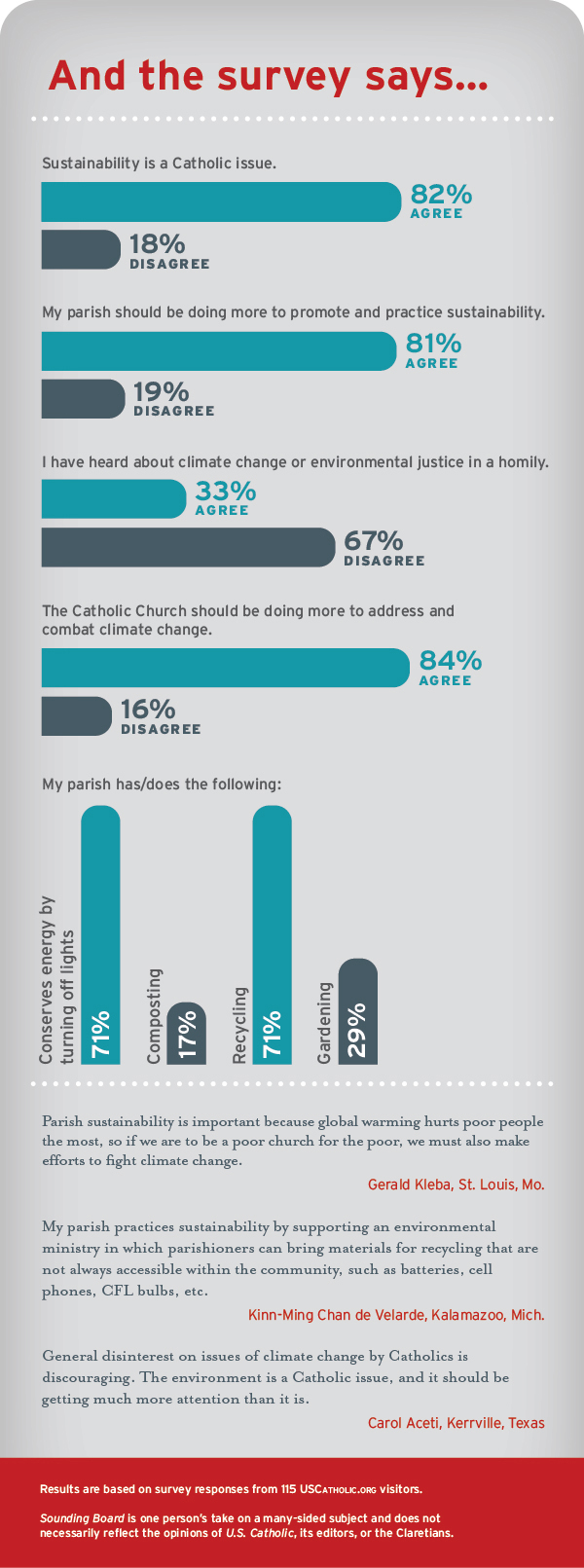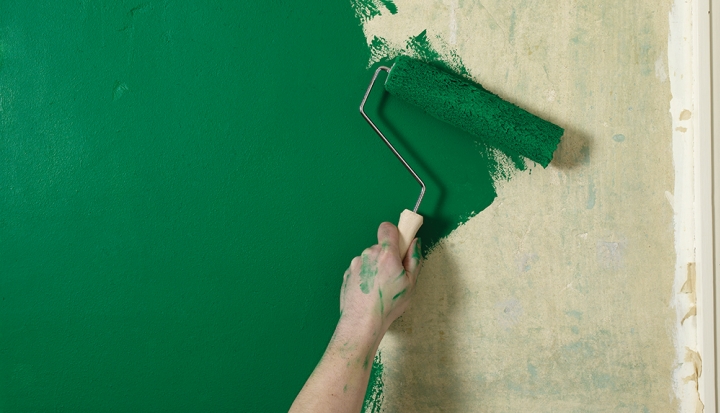In May 2015 Pope Francis released Laudato Si’ (On Care for Our Common Home). In his second encyclical, the pope urges Catholics to be mindful of their environmental impact and to actively work for environmental justice. He says of the importance of sustainability, “Many things have to change course, but it is we human beings above all who need to change.” U.S. Catholic surveyed readers to find out how parishes across the United States are answering this call.
Of the 115 people who took the survey, 82 percent say that sustainability is a Catholic issue. Seventy-one percent say their parishes recycle while only 17 percent say their parishes compost, and 29 percent say their parishes have a garden. Although only 14 percent of readers’ parishes take part in a community-supported agriculture program, 25 percent say their faith community makes efforts to promote environmental advocacy.
Despite some parishes’ efforts to be more sustainable, 81 percent of survey respondents say that they think their parish should still be doing more to practice greener habits.
No matter where your faith community is in your journey to sustainability, there are myriad ways to green your parish. First step? Start a green team. A green team is a group of three or more people from your parish who, through leadership, educate and connect fellow parishioners to sustainability resources and advocate for healthier communities.
Members should strive to be conscious of Earth care and keep justice for our neighbors at the forefront in your house of worship. A group of people working together to build a healthier and more sustainable community will accomplish far more than anyone trying to do this alone.
Meet regularly with your green team to connect your parish’s spiritual practices and traditions with concerns for our shared land, water, and air, as well as justice for our neighbors. Strive to educate your faith community, motivate fellow parishioners to incorporate environmental consciousness into all activities, and celebrate your sustainability accomplishments.
An important step to ensuring that your parish is successful as it becomes more sustainable is to choose a green team focus. Focusing on one issue at a time will make it easier for your parish to make the switch to becoming environmentally conscious. You may choose to focus on energy, food and land, or water usage. Following are some ways to hone in on these areas and make changes that will make your parish greener and more efficient.
Energy and climate
The health of our communities and the planet is greatly impacted by the amount of energy we use and the way it is generated. Power plants that burn coal and natural gas to generate electricity are the largest emitters of carbon dioxide, a greenhouse gas that contributes to climate change. You may want to focus on reducing your parish’s impact on greenhouse gas emissions by reducing its use of energy.
A simple way to reduce energy use is to encourage carpooling at your parish. According to the Union of Concerned Scientists, cars and trucks contribute to nearly one fifth of all U.S. emissions. That means we emit 24 pounds of carbon dioxide and other greenhouse gases for every gallon of gas used.
By implementing a carpooling program to and from Mass and other parish events, your church can help cut down on the amount of emissions caused by cars.
To reduce the amount of energy your parish uses through electricity and other forms of power, find an organization that will do a free energy audit for your parish or ask your utility company if it provides this service.
This audit is a key first step to laying out a comprehensive road map for energy conservation and, in turn, will save your parish money on utility bills. The audit will check for areas of opportunity for sustainability, including behavior changes in internal energy use and upgrades to heating and cooling equipment, lighting, and appliances that will reduce the amount of energy your parish uses.
After conducting an energy audit, your parish can choose to take further steps in reducing your carbon footprint by installing solar panels on your church.
Sustainable food and land use
It is vital to our surrounding ecosystems that we preserve the amount of land remaining and protect native vegetation. The prairies, wetlands, and forests that provide food and habitat for butterflies, birds, insects, and other species have all but disappeared. Many houses of worship spend a lot of money on lawn maintenance and chemical sprays to keep a manicured lawn.
Have your parish work in partnership with local natural areas and forest preserves to learn about removing invasive species and planting native species to increase the biodiversity and overall health of your area. Consider using some of your parish’s land to create a community garden to address food insecurity in your community.
If your parish is interested in creating sustainable options for members to purchase food, consider participating in Faith in Place’s Congregation-Supported Agriculture program. These initiatives not only partner with local farmers to provide parishioners with fresh, local produce but also commit to donating 10 percent of that food to local food pantries.
Check out Faith in Place’s website (faithinplace.org) to start a Congregation-Supported Agriculture program at your parish.
If your church has some land, you can also start your own vegetable garden. This is a great way to teach parishioners about farming as well as to connect your faith community to the Earth.

Water preservation
All the water we have on Earth is all the water we’ll ever have, and only a very small percentage of that water is drinkable. We need to learn to conserve and protect this water for future generations. Water is life.
To preserve water at your parish, set up rain barrels to catch fresh water and prevent runoff during storms. The rain barrels can store water that can be used to irrigate landscaping or water a vegetable garden. Reducing the amount of water that could turn into runoff during a storm will prevent dangerous flooding as well.
To tackle water preservation on a larger scale, get your green team together to study Faith in Place’s “Our Grandchildren’s Water” curriculum, which is available on the Faith in Place website. This interfaith curriculum explores the central role water plays in world religions and the obligation people of faith have to conserve and protect this precious resource.
Advocacy
The actions that individual people and faith communities take to care for the Earth make a big impact. However, there’s only so much we can do when we act by ourselves. There are policies and systems that need to be changed to protect the land, air, and water we all share.
With your parish community, become familiar with local issues on the municipal, state, and federal levels and then decide how to become involved to advocate for change. Look for local partners to join in this work. Faithful citizens engaging with their local, state, and federal leadership can be a powerful force for change.
To succeed in creating a more sustainable and environmentally mindful parish, the key is to create a plan and a timeline of your green team’s goals and set benchmarks for success. Remember to celebrate these successes and even failures on your journey to “green” your parish.
This article also appears in the November 2019 issue of U.S. Catholic (Vol. 84, No. 11, pages 27–31). Click here to subscribe to the magazine.
Image: iStock













Add comment